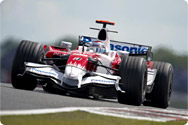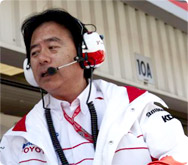Grand Prix > Grand Prix of Great Britain > Review
|
|
08 July,2008 (Tue)
Thank you for your support over the weekend. The British Grand Prix this weekend capped off the first half of the 2008 F1 Championship. Nine races down, and nine races to go. Here is my report from the British GP, conducted under typical “British weather” conditions.
 The front wing was the most significant of the modified parts brought to the race. This new part helped secure a good result at Magny–Cours, and was modified for the Silverstone course. The part is essentially brand new to the team, since it wasn’t used during the prior week’s tests.
The front wing was the most significant of the modified parts brought to the race. This new part helped secure a good result at Magny–Cours, and was modified for the Silverstone course. The part is essentially brand new to the team, since it wasn’t used during the prior week’s tests.Modifying the new wing that produced good results at the French GP
We captured our first podium finish in two years at the French GP, held two weeks ago. Panasonic Toyota Racing came to Silverstone with high morale. Nevertheless, the world of F1 isn’t such that we could lightly expect a second consecutive finish. Our podium finish at Magny–Cours was the result of the perfect combination of new aero parts, solid car settings, correct race strategy, and driver determination. Accordingly, we had many long, detailed meetings before coming to the British GP, bracing ourselves for a tough F1 fight.
We were able to successfully test our “Silverstone” aerodynamic package at the joint tests held one week ago here at this circuit. While we didn’t use it during testing, we brought an improved, modified wing based on the new front wing we used at the French Grand Prix two weeks ago. The conditions were quite windy during the testing session–not very favorable for assessing aerodynamic parts. Our plan was to get in a lot of laps on the first day of the grand prix weekend, collecting as much data as we could about the behavior of the new wing and other aero parts designed for Silverstone.
 The center pillar attaching the rear wing was another new part, but the team changed back to the old part after Jarno’s wing fell off on the course. Jarno suffered a high–speed crash, but came away unharmed, to everyone’s relief.
The center pillar attaching the rear wing was another new part, but the team changed back to the old part after Jarno’s wing fell off on the course. Jarno suffered a high–speed crash, but came away unharmed, to everyone’s relief.Frustrations with both cars; collecting good feedback about our chassis by late Friday
With the weather forecast calling for a high chance of rain on Saturday, we started out on Friday hoping to collect a lot of on–course data. Unfortunately, trouble threw a wrench in our plans. First, Timo (Glock) experienced trouble with his clutch. We still haven’t identified the cause, but the trouble started right after the car bottomed out coming off the curb in the prior corner, which led us to suspect that as the cause.
Meanwhile, Jarno (Trulli) had the rear wing detach from his car while out on the course. We had been using a new part to attach the rear wing (center pin) to Jarno’s car. With the failure, we changed over to a former part with proven reliability. We also substituted this part for the new part in Timo’s car before he went back onto the circuit during the last stage of the free practice session.
Allowing a series of problems like this is something that we will have to seriously address. Even with the trouble, I didn’t think our cars were performing that badly. Our lack of pace was due to limited on–course time, as well as our testing several different mechanical settings. Our basic setup had already been confirmed the week prior, so we weren’t overly concerned at this stage in the practice rounds.
 Timo’s car hit the curb hard on Friday–a shock hard enough to crack the monocoque, which was replaced. While a connection was never clearly established, the car experienced clutch problems immediately after.
Timo’s car hit the curb hard on Friday–a shock hard enough to crack the monocoque, which was replaced. While a connection was never clearly established, the car experienced clutch problems immediately after.A sudden issue with bottoming during the Q2 prevents us from showing our true colors
Our cars performed fairly well during Saturday morning’s free practice, and we went into afternoon qualifying feeling that we had found the settings that would get both cars into the final qualifying period. Looking at the weather forecast, rain during qualifying was certainly not out of the question, so we had our drivers go on their attack laps early in the period. As expected, rain started to fall during Q1, but both drivers had turned in times fast enough to move on, allowing us to reach Q2 without incident.
Once we started Q2, our cars began to bottom out, scraping the underside on the track. Timo complained about bottoming during his first attack in Q1, so we added some tire pressure to raise the chassis, eliminating the problem. However, the increase in tire pressure appeared to affect our grip levels, keeping us from securing a satisfactory lap time during Q2.
On the other hand, Jarno had no issues during Q1, but suddenly experienced bottoming at the most important time during his attack run in Q2. Immediately after starting his hot lap, Jarno’s car scraped in high–speed corners 1, 5 and 7, forcing Jarno off the accelerator, and preventing him from scoring a better time.
We have to go back and look at the data to see why we suddenly experienced bottoming during qualifying, particularly during Q2, but it was clear to us that the issue was not directly linked to the problems of the prior day. Further, Timo’s monocoque developed a crack after bottoming out hard on the curb during Friday’s free practice, so we replaced it with the spare.
 After a disappointing Saturday, both drivers got off to a strong start in the race on Sunday, gaining position under rainy conditions. The typical Silverstone rains caused the team to struggle with tire selection, but Panasonic Toyota Racing came away with significant gains as they won points and moved up in the championship.
After a disappointing Saturday, both drivers got off to a strong start in the race on Sunday, gaining position under rainy conditions. The typical Silverstone rains caused the team to struggle with tire selection, but Panasonic Toyota Racing came away with significant gains as they won points and moved up in the championship.Satisfied with winning points; more decisive tire selection needed for greater results?
Considering our starting position on the grid, you might think we would be very pleased with our race result. But the results were actually somewhat disappointing, considering that we could have finished even higher had we taken a different strategy.
As with the Monaco GP, our start was strong, and both cars were able to pass through the control line on the first lap moving up in position through the wet conditions. The rain had stopped by the time the cars lined up on the grid, and we believed the course would gradually dry out, so we decided to go longer before the first pit stop. But right before we pitted a light rain started to fall. At that point, the grooves of the standard wet tires (shallow grooves) had worn down quite a bit, so both drivers were forced to drop their pace. The general theory is that drivers taking a later pit stop move higher in position. In contrast, we actually lost position by taking a longer first stint.
In spite of that development, we went with a heavy fuel load in an attempt to reverse our losses, but the rain started to fall even harder after our stop. Since we had just changed our tires, and we had reports that the rain was only temporary, we hesitated to change tires again. While we were hesitating, Jarno’s tire pressure began to fall off, and he lost pace on the track. At one point, Jarno was fighting for a spot on the podium, but the significant time loss removed him from contention. The rain also affected Timo’s car, keeping him out of the points at the finish. We believed that changing over to extreme weather tires (deep grooves) would be a risk, but had we changed more quickly to a new set of standard wets (shallow grooves) things may have developed quite differently for us.
Even so, we should be happy that we were able to finish P7 and earn two championship points after starting the race out of the top ten. Adding two more constructor’s points, we have moved up to 4th in the Constructor’s Championship.
We will be introducing new parts at the next race of the season, the German Grand Prix. We hope to hear you cheering us on.

Noritoshi Arai at Silverstone. With Jarno finishing P7, Panasonic Toyota Racing moves up to 4th in the Constructor’s Championship! The next race is the German GP—a “home race” for Panasonic Toyota Racing. Of course the team will be fighting to move up!




